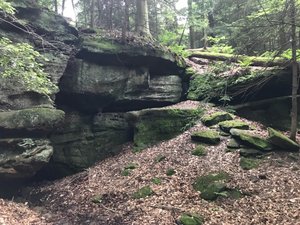Advertisement

 B6C11FC4-A59D-44BA-9556-B6D7EBED7274.
B6C11FC4-A59D-44BA-9556-B6D7EBED7274.
Very Old Rock Formations at The LedgesCuyahoga Valley National Park, Cleveland/Akron, Ohio
This is truly a spectacular park. And yet, it is very difficult to explain what makes it such a treasure. The mountains aren’t nearly as spectacular as the Great Smoky’s. The hemlock and beech forests are soothing and lush, but not nearly as tall as Congaree or Redwoods. There is no Old Faithful geyser, or anything like it to draw throngs to a single spot.
The closest thing I can compare it to is Central Park in the middle of New York City, although Central Park is substantially smaller. Cuyahoga Valley, like Central Park, is known as an ‘urban retreat’, a place city people can go to to restore their energy and re-embrace nature. As we explored this park over the last couple of days we did run into out-of-staters on occasion, but by far most of the license plates were from Ohio and the people we talked to mostly lived right there in Cleveland, Akron, or surrounding suburbs. Although there were some very bitter politics involved in the 60s and 70s to create this park, it seems that nearly everyone now accepts it as a vital part of the rhythm of this
metropolitan area.
There are so many ways to explore this park. You can even drop a canoe in the river and traverse the length of the park by boat, stopping at various points to explore inland. The natural core of the park is the Cuyahoga River which runs from beyond Akron, down through the park and empties into Lake Erie at Cleveland. If you are as old as I am, you remember this river as the one that was so polluted that it caught on fire in the mid-70s. It became a powerful symbol of how callous we were treating our natural environment and was so sickeningly thick with chemicals and wastes that nothing except maybe petroleum eating bacteria were able to live in it. Park literature still does not recommend swimming in this river and cautions against drinking the water, but the efforts here, in part coming from the work in the National Park itself, also show that nothing is irredeemable - if you put enough effort (and money) into fixing things, we can as a community, restore nature to what it once was. Life is returning to the valley - fish are back in the water, birds
that had once disappeared are returning, there are even beavers back on the river now. Although there is still much to be done, Cuyahoga Valley is part of an environmental success story.
Another way to see the park is by car and that is a popular way to do it. For most people, that is about the only way to get there. We have to drive in because there are no other options to get there. Riverview Road parallels the river throughout most of the parks 20-mile length. There are parking lots scattered near most attractions. I can imagine in the summertime peak season that finding spots might be a little difficult, but we were there on a Saturday yesterday and didn’t have any problems parking anywhere.
We started our visit on Friday morning at the main park visitor center in the town of Boston. The visitor center occupies an old restored building that originally occupied that site back in the early 1800s when the valley was primarily an agricultural center of mostly subsistence farmers. Originally, Ohio was part of Connecticut and the valley was originally settled by folks from New England. The architecture and agricultural customs reflected
that origin. We spent about an hour talking to rangers and volunteers there who were absolutely stunned that we had five days to explore their park - most people just spend a few hours - so we got the royal treatment with tons of literature and lots of ‘my favorite place is...’ kind of tips. The movie there is also a must to get an overview of the history of both the valley and the effort to build the park there. (Note: I also got my first taste of a Buckeye - a chocolate and peanut butter confection that really puts Reese’s to shame.)
Boston is one of two ‘towns’ that are at the center of the park. They contain business and residences and so, I assume, they are separate from the park. But the boundaries are so transparent that you just sort of move in and out of them as you explore. Another ‘town’ is Peninsula, and we drove the four miles down Riverview Road to go there after exhausting the rangers with our questions. In Peninsula, there is another Trail Mix store, which is the name of the park gift shop run by the park’s volunteer support
organization. We bought some souvenirs and, of course, a couple more books to help us understand the park.
Overwhelmed with information, we retreated to Fisher’s Cafe in Peninsula for a drink and late lunch. There with all the pamphlets and maps spread around our table, we tried to get a grasp of the park and what we wanted to see. Hungry for some good protein, we both ordered steaks - they were good, but maybe not the best steak I’ve ever had. After lunch, still a bit overwhelmed, we drove back to the campsite and tried to get to bed early. I started the book I bought earlier in the day. (More on that in another post.)
Yesterday, we planned to explore the park in yet another way - by foot. Dogs are allowed anywhere in the park except in buildings (as long as leashed and picked-up-after.). So we decided to take them into the park for a modest 2.5 mile hike around what is called The Ledges. The name comes from the geological features that the hike circles. The rocks here are truly ancient dating back more than 325 million years to Paleozoic times. After glaciers came
through the area and scraped off most of the sedimentary rock, what was left was a conglomerate of rocks that are really old. The hike takes you in and around these formations. The forest growing around them is dense enough that everything is really cool and moist supporting lichens and moss. Some of the pictures show that. Since it was cool enough, the girls managed the hike just fine. Besides, we got lots of ‘look at the cute corgi’ comments. Joan, being a proud Corgi Mom, really likes that. After the hike we returned to Fisher’s cafe for a a couple of Long Island Iced Teas and lunch. This time I had a brisket burger which was much better than the steak. And we planned the rest of the afternoon, deciding to tackle the three remaining sites in the southern part of the park, towards Akron. So we drove maybe three or four more miles down to the Ira Road parking lot for another short hike up to Beaver Marsh.
Now I have to explain what is perhaps the most significant feature of this park - the Towpath. In a stroke of genius, one of the first things the
park service did when they started this park, was restore the Ohio Canal Towpath as the central feature of the park. The historical significance of this part of the Cuyahoga River is that it became the site for the Ohio-Erie Canal. The book I’m reading goes into all the details about how this thing got built, and I will probably talk about that some more. For now, though, the short version of the history is this -
When Ohio was first settled, all the settlements were in the southernmost part of the state, concentrating along the Ohio River. In fact, in the early 1800s, the largest city was Cincinnati. This made a lot of sense as the main trade routes were down the rivers into the Mississippi with all the opportunities that offered. Although it is difficult for us to understand this now, given the current geography of Ohio, the northernmost parts of the state were really very barren - because there were simply no trade opportunities.
After New York built the Erie Canal, though, things changed dramatically. Now people saw opportunities flowing through Lake Erie and back to the North Atlantic. Then some early Ohioans got the
bright idea about what it would mean if they could connect the two trade routes - the Lake Erie route and the Ohio River route. That would open up all kinds of transportation, and trade, options and put Ohio right in the middle of it all.
There is just one little problem which becomes obvious when you look at a topographical map of Ohio - there are no natural routes between the northern and southern parts of the state. In fact, running horizontally through Ohio at a point a little south of Akron is a kind of continental divide - rivers north of it empty into the Great Lakes, and rivers south of it empty into the Ohio. A bridge would need to be built to cross that divide. And so the idea of a canal connecting the Cuyahoga river and the Scioto River came about. It was not a small effort, but after the successful completion of the Erie Canal, there was a wealth of experience, and labor, available for the Ohio-Erie Canal, with dozens of locks and approximately 300 miles of canals built largely of stone. (As a side note, capitalism was totally unable to even conceive
of taking on this kind of risk - the canal was built by the efforts of the state of Ohio. Of course capitalism was fully invested in taking advantage of the effort once it was completed. But, significantly, this was a government enterprise, not a private one.)
So a key part of this park is the canal system that was built in the 1830s. And the Towpath was the mechanism for hauling the canal boats up and down the canals and through the locks. The genius of the park system in the early 70s was to see the towpath as the core feature of the park, available for hikers, and cyclists.
We got out of the car at the Ira Road stop on the towpath and hiked a quarter mile up the path with the girls to the Beaver Marsh. This is another park success story. At the beginning of the park, this was a gravel quarry and an automobile salvage operation. The service took this on as one of its first projects. Today, it is a rich marshland with hundreds of species of fish, birds, plants, and bugs, all creating a teeming environment. Significantly, multiple beavers have
returned and, although we didn’t see them, we did see some of the dams they have built creating this wetland. It is truly a marvel of conservation work and gorgeous to look at.
On the way back home, we stopped at two more sites in the park. The Hunt house is a restored home modeling another farmhouse of the time. And the Everett covered bridge is also a restoration of what covered bridges (remember that the original settlers came from New England) would have looked like. From there we drove back home, tired but feeling good about our hiking day in the park.
Advertisement
Tot: 0.062s; Tpl: 0.012s; cc: 11; qc: 24; dbt: 0.042s; 1; m:domysql w:travelblog (10.17.0.13); sld: 1;
; mem: 1mb











